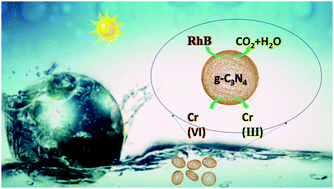Synthesis of hollow donut-like carbon nitride for the visible light-driven highly efficient photocatalytic production of hydrogen and degradation of pollutants†
Abstract
Hollow donut-like g-C3N4 (CMU-500) was prepared by controlling the calcination temperature of a supramolecular polymer composed of cyanuric acid, melamine and urea at 500 aC in air. CMU-500 possessed a large specific surface area of 92 m2 g−1, which is ten-fold higher than that of bulk g-C3N4. It exhibited high separation efficiency for photogenerated electron–hole pairs and high conductivity for interfacial charge transfer. CMU-500 exhibited high visible light photocatalytic activity for the degradation of rhodamine B (k = 0.364 min−1) and reduction of Cr(VI) (k = 0.463 min−1), in which the rate constant, k, was more than 30 times that of bulk g-C3N4. The hydrogen production efficiency of CMU-500 with Pt as a co-catalyst was as high as 2260 μmol g−1 h−1 under visible light irradiation, which is 180 times higher than that of bulk g-C3N4. Highly stable photocatalytic activity was observed in both photocatalytic degradation and hydrogen production through four cycles of tests. Thus, our results suggest a new strategy to design and synthesize highly effective photocatalysts towards the treatment of environmental pollution and hydrogen production.



 Please wait while we load your content...
Please wait while we load your content...